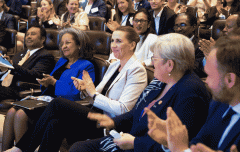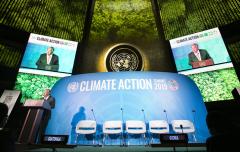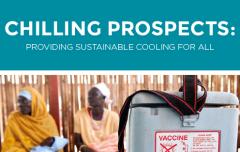How to cool down as the world warms up fast
By Jeppe Kofod, Danish Minister for Foreign Affairs, Dr. Seleshi Bekele, Ethiopian Minister of Water, Irrigation and Energy, and Rachel Kyte, CEO and Special Representative of the UN Secretary-General for Sustainable Energy for All – all co-leads of the Energy Transition Track at the UN Climate Action Summit.
It has been a hot year so far. In France, Belgium and Germany, summer temperatures reached such highs that records were broken twice in just 24 hours. Dangerous heatwaves were felt yet again across India, Africa, Russia and the Arctic – the list goes on.
From the poles to the tropics, the world is getting hotter and the destructive effects of the climate emergency are being felt. Unsurprisingly, this has brought greater attention to the issue of cooling - often taken for granted - and has begged the questions: how do we deliver cooling sustainably in a warming world and how do we keep people, medicines and food safe?
For over 1 billion people, their ability to survive and thrive is undermined without access to sustainable cooling
But what is cooling? Your mind first turns most likely to air-conditioning. But cooling, and how it touches our lives, is about so much more. Cooling is essential to keep food nutritious, vaccines effective, and people safe during heatwaves. In hot climates, it makes economies productive, and for growing numbers of people, life without it is unimaginable.
The impacts are plain to see. Heatwaves already kill an estimated 12,000 people annually across the world, a number the World Health Organization says will grow to 255,000 people per year by 2050 if unchecked. Nearly 20% of temperature-sensitive healthcare products in India arrive damaged or degraded because of broken or insufficient cold chains, including a quarter of vaccines.
Sustainable Energy for All research shows that for over 1 billion people, their ability to survive and thrive is undermined without access to sustainable cooling. It puts out of reach hopes for health care and nutritious food, good schools and comfortable workplaces.
Sustainable cooling is essential for economic growth, and without it, it will be the developing world that feels the most significant “productivity penalty”. By 2050, work hour losses - worth billions of US dollars - due to excessive heat and lack of access to cooling are expected to be more than 2% and as high as 12% in the worst-affected regions of South Asia and West Africa.
In a warming world, cooling is not a luxury. It is an issue of equity, and an urgent and growing problem that calls for fast action.
Delivering cooling sustainably - using little energy and without polluting hydrofluorocarbons (HFCs) that speed global warming - will also be essential for energy systems to be in line with the triple challenge: meeting sustainable energy for all as agreed under the Sustainable Development Goals; the Paris Agreement with the promise of keeping global warming below 2 degrees Celsius; and the Kigali Amendment to the Montreal Protocol to rid ourselves of HFCs.
By 2050, indoor cooling alone will consume as much electricity as India and China today. If we don’t start grappling with cooling sustainably, the spike in energy demand and climate-forcing pollutants will drive a dramatic rise in greenhouse gas emissions.
Roofs and renewables
Solutions exist. For example, new innovations in off-grid “cold chain” refrigeration that need little power to get a farmer’s goods safely from farm to table without spoiling. Scaling up innovations and investment in clean cold chains can boost farmers’ incomes, help people lead healthier lives, and reduce food waste.
We must think holistically about reducing demand for cooling. There are simple and cost-effective solutions, including moving to cool roofs, painted white or planted green. We can also use solar power to drive fans for people living in densely packed slums, creating safer living conditions and reducing the dangers of frequent power outages during heatwaves.
In rural villages, renewable energy can power cooling for schools and clinics, meaning that children can have more productive days at school and families can take their children to be vaccinated with confidence that it will be effective.
These efforts can be supported in three ways. One, increase finance and deployment of energy-efficient solutions; two, invest in zero-carbon or no-to-low global warming cooling innovations for the future; and three, think systematically about meeting cooling needs while minimizing energy demand, utilizing access solutions like district cooling and solar home systems.
Collective action
We must also collectively rethink how we understand cooling needs across cities and cold chains, and design and finance solutions and technologies that meet those needs.
Leading governments should integrate cooling into their national climate action plans, setting strong energy-efficiency requirements for building codes and cooling technologies.
Cities must integrate cooling needs into urban planning, develop heat action plans to protect the vulnerable in heatwaves, and paint roofs and walls white to reduce the urban heat island effect.
Industry can invest in energy-efficient cooling of their production facilities and value chains. Technology providers can help deliver affordable and sustainable solutions by working with the public sector to bring the best technologies to scale. Investors can set requirements for energy-efficiency in investment projects.
Next week at the United Nations’ Climate Action Summit, the energy transition track – led by Denmark, Ethiopia and Sustainable Energy for All - will shine a light on the need for sustainable cooling. This work will highlight the innovative solutions from forward-thinking businesses, and see governments commit to national cooling plans that meet the needs of their citizens with hyper-efficient energy solutions. As the summer begins to cool down for many, we must not let our action and commitment to this challenge cool off with it.
This opinion piece first appeared on Thomson Reuters Foundation News and can be found here
Photo credit: ADB




